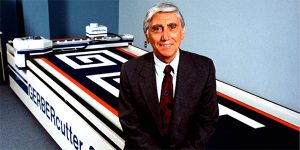
HIGHLIGHTS
Many consider Joseph Gerber the “Thomas Edison of manufacturing” as a pioneer in automation development in skill-intensive industries.
Born into a Jewish family in Austria in 1924, Heinz Joseph Gerber showed technical prowess at an early age – by the time he was only eight, he had built radios and developed magnetic circuit breakers to preserve his batteries. He was thirteen when Germany annexed Austria in the Anschluss. He and his father were imprisoned in a Nazi labor camp shortly thereafter. He was released and, in 1940, he fled to the U.S. with his mother. His father did not survive the Holocaust.
After reaching the U.S., he completed high school in two years, learning English along the way. He attended Rensselaer Polytechnic Institute on a scholarship and graduated with a degree in aeronautical engineering after only two and a half years. While a junior in college, he developed the Gerber Variable Scale, a graphical computing device for analyzing graphical curves. After college, he founded the Gerber Scientific Company to produce this and other instruments. Before the development of digital computers, the analysis of graphically recorded data was complex and time-consuming. The Gerber Variable Scale greatly simplified this process, and it has been described as being as important an engineering tool as the slide rule. Other advances in graphical analysis include the Gerber GraphAnalogue, which performs computations on graphical data; the Gerber Derivimeter, which gives the derivative of a curve; and the Gerber Equameter, which derives an equation to describe a curve based on a mathematical series without any mathematical expertise on the part of the user.
Gerber was an early adopter of computer-assisted design and tooling. His inventions became widely used in transport industries.
- His automated drafting technologies enabled the design of complex products, such as the Boeing 747 and the Lockheed C-5 Galaxy.
- His automated design technology permitted integration with numerically controlled manufacturing techniques, which led to significant savings in costs and manufacturing times.
- His drafting developments became increasingly sophisticated as computers became more powerful – he released the Interactive Design System IDS in 1974 and was a major supplier of computer-aided design (CAD systems) to companies such as Boeing and General Motors.
In the 1960s, Gerber turned his attention to the textile and apparel industries, which were rapidly leaving the country because of the high labor costs associated with cutting and sewing fabric. Gerber developed machines to address both problems. In 1969 he introduced the GERBERcutter S-70, which was able to accurately cut cloth for fifty men’s suits in less than three minutes. Two years later he was selling the first numerically controlled sewing machines. These developments helped to slow the departure of the apparel industry from the U.S. by some decades.
Gerber was responsible for significant developments in other industries, including shoemaking, printing, sign-making, prescription eyewear, packaging and labeling, and electronics fabrication. He was inducted into the National Academy of Engineering in 1982. He was awarded the National Medal of Technology in 1994 for his “technical leadership in the invention, development, and commercialization of manufacturing automation systems for a wide variety of industries.”
Gerber died in 1996 at the age of 72, with patent applications still pending at the PTO.
Author: Iain McIntyre
